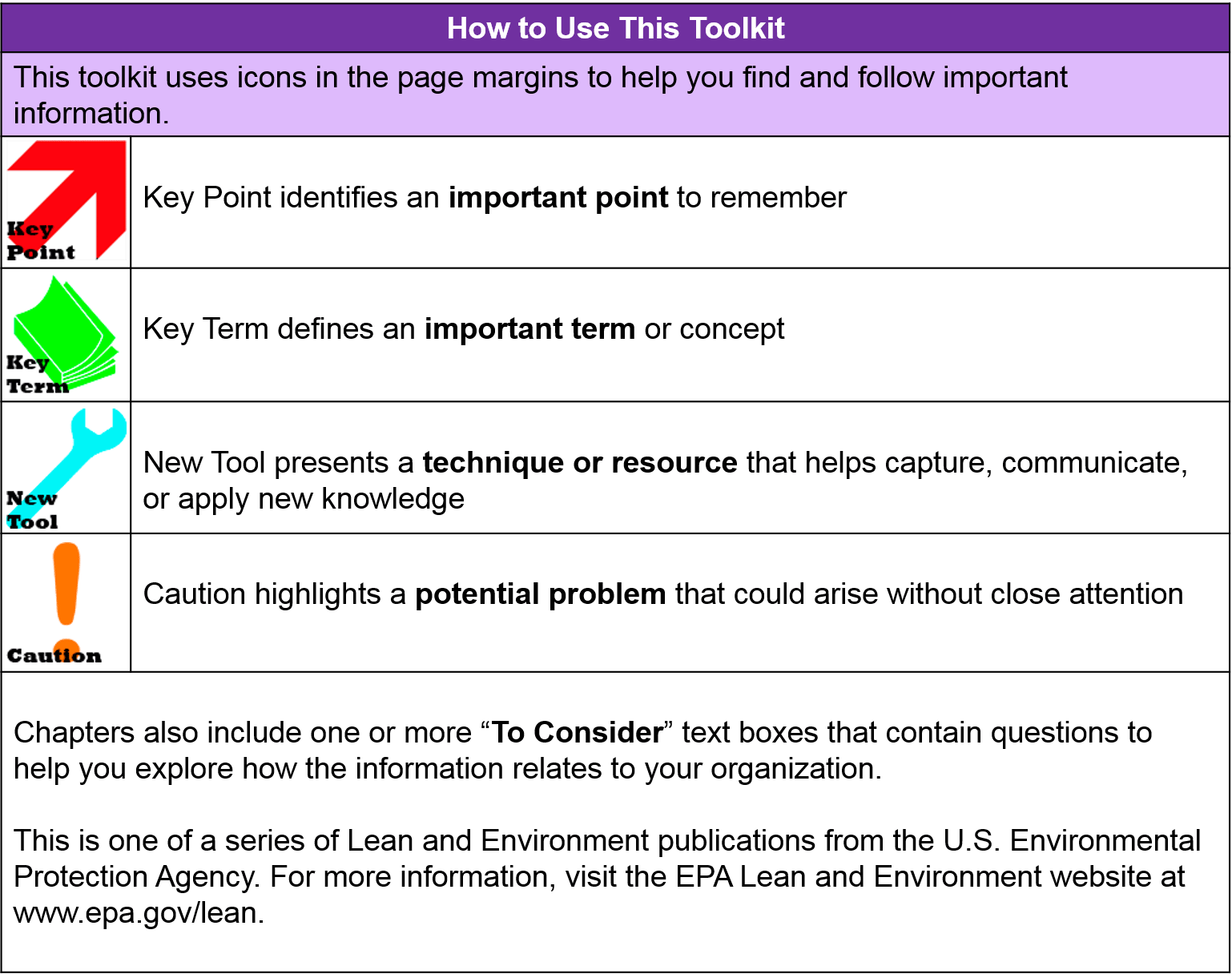Lean & Chemicals Toolkit: Preface
- How to Use This Toolkit
- Purpose of This Toolkit
- Key Questions Addressed by This Toolkit
- A Vision for Lean and Chemicals Efforts
- To Consider
- Footnotes
- Toolkit Navigation
How to Use This Toolkit

Purpose of This Toolkit


Key Questions Addressed by the Toolkit
Lean works well when it focuses on identifying and eliminating waste. Environmental improvement and chemical reduction efforts that could distract Lean efforts from this prime focus may not get much traction. By contrast, this toolkit contains strategies and techniques that can enable Lean practitioners to easily identify chemical wastes and improvement opportunities alongside the myriad other wastes and improvement opportunities uncovered by Lean. To accomplish these objectives, the toolkit aims to answer the following questions:
What is the relationship between Lean and chemicals?
By eliminating manufacturing wastes, such as unnecessary chemical use, and improving management of chemicals, businesses can reduce costs and risk, while better meeting customer needs. In addition, companies that eliminate harmful chemicals from their products can gain potential market advantage from eco-labeling and certification programs. Chapter 1 describes the benefits of learning to see chemical wastes as part of Lean implementation and combining Lean and chemical use reduction efforts. Chapter 2 provides background information on chemical manufacturing, management, and use.
How can one reduce chemical wastes using Lean events?
A key step in effective Lean and chemical efforts is learning to see chemical wastes in the context of Lean methods and identifying where to target chemical reduction activities. Chapter 3 examines specific techniques for using Lean methods to identify and eliminate chemical wastes. Methods examined in this chapter include value stream mapping and kaizen events.
How can one improve chemical management in Lean workspaces?
Lean implementation can bring significant changes to how work is configured in the workplace and, as a result, to how chemicals are managed. Chapter 4 describes how Lean strategies such as cellular manufacturing, just-in-time delivery, and “right-sizing” affect chemical management, and presents Lean approaches to chemical and hazardous waste management. Chapter 5 examines workspace-level opportunities to eliminate chemical wastes, focusing on Lean methods such as point-of-use storage, 6S (5S + Safety), visual controls, and Total Productive Maintenance (TPM).
How can Lean design tools be used to reduce chemical costs and risks?
Lean design methods offer a powerful way to reduce chemical use and risk in products and processes. By asking the right questions related to chemicals during Lean design efforts, organizations can better design products and processes that reduce costs and risk while also meeting customer needs. Chapter 6 provides an overview of Lean design tools—such as 3P, Quality Function Deployment, and Design for Manufacturing and Assembly—and describes opportunities for integrating chemical considerations and environmental design principles.
A Vision for Lean and Chemicals Efforts

In their well-regarded book on industrial design, titled Cradle to Cradle: Remaking the Way We Make Things, William McDonough and Michael Braungart present a compelling vision that is highly relevant to Lean and chemicals initiatives1. Two key components of this vision include:
- Produce products and services that do not consume (during production or use) or contain toxic or hazardous chemicals that customers did not ask for and did not know were included.
- Produce products that, when their useful life is over, do not become useless waste but can be composted to become food for plants and animals and nutrients for soil; or alternatively, that can return to industrial cycles to supply high-quality raw materials for new products.
This toolkit can be a springboard for working towards this vision. It describes strategies and tools for reducing the risks, costs, and time associated with using chemicals and managing hazardous wastes, while also supporting Lean’s overall goals of continual improvement and waste elimination.
Given recent regulatory, product labeling, and consumer preference trends, it is likely that pressures to identify and eliminate harmful aspects of chemical use will increase in the future. Companies that can leverage their Lean initiatives to identify and eliminate chemical waste can enjoy significant competitive advantages as they seek to win and retain customers.
Footnotes
1 William McDonough and Michael Braungart, Cradle to Cradle: Remaking the Way We Make Things, North Point Press, 2002.
Toolkit Navigation
- Contents & Acknowledgements
- Executive Summary
- Preface
- Chapter 1: Introduction
- Chapter 2: Chemicals Overview
- Chapter 3: Driving Out Chemical Waste with Lean Events
- Chapter 4: Chemical Management in the Lean Organization
- Chapter 5: Managing Chemicals in Lean Workspaces
- Chapter 6: Lean Product and Process Design Methods
- Chapter 7: Conclusion
- Appendix A: Chemical Resources
- Appendix B: Material Safety Data Sheet Template Example
- Appendix C: Point-of-Use Storage Request Form Example
